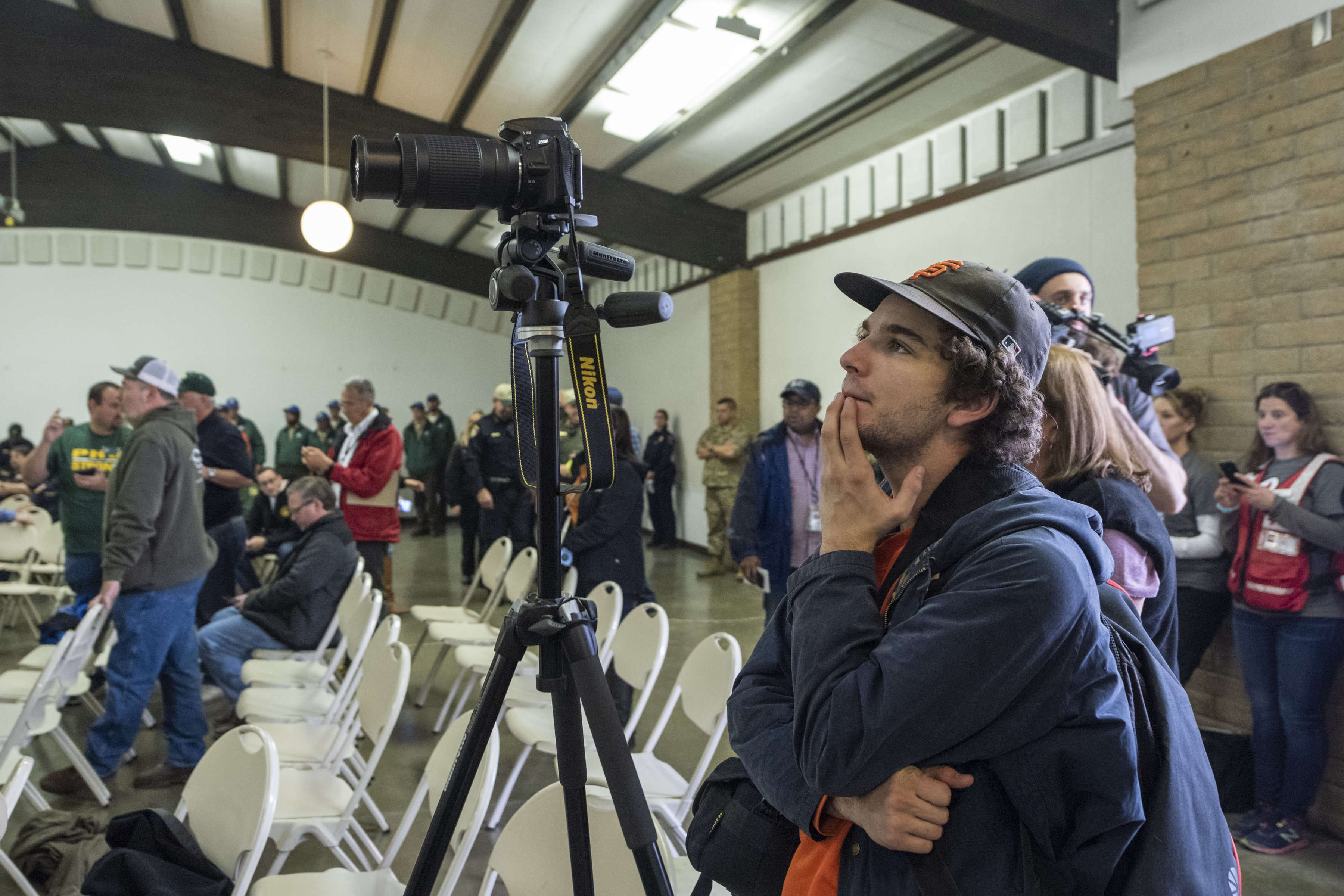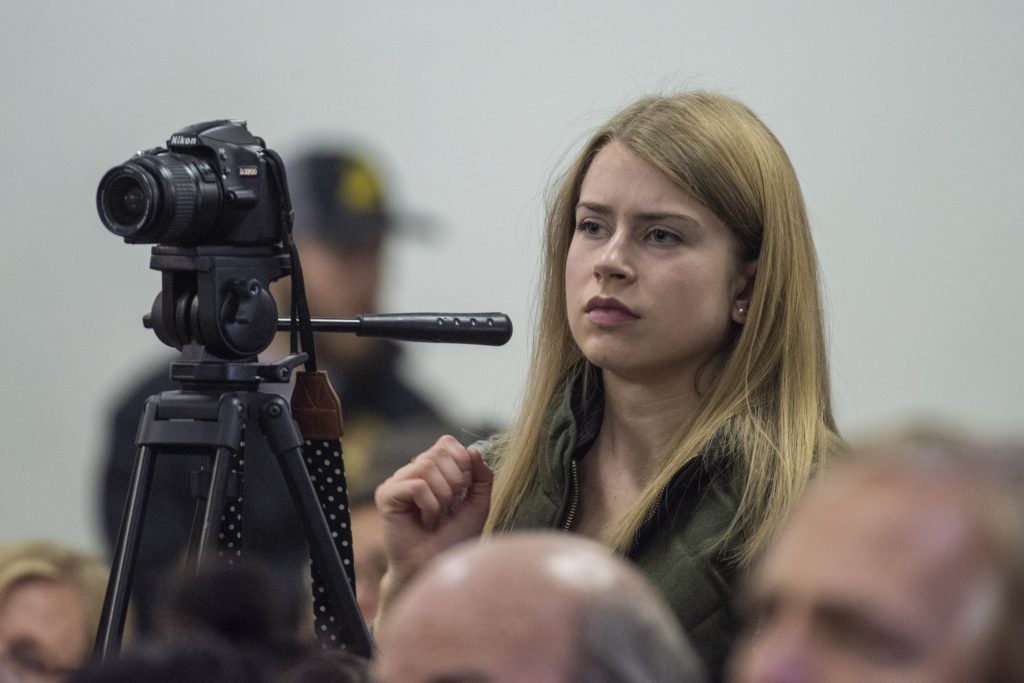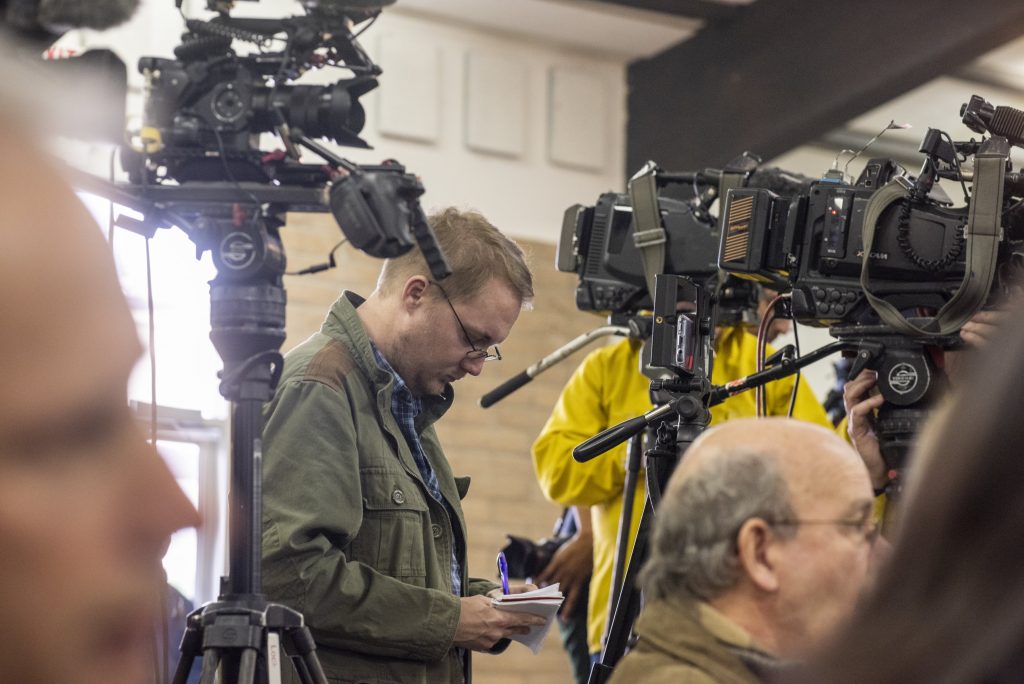Next-Level News

Orion reporter Alex Grant reports on Governor Jerry Brown who joined state, local and federal officials – including U.S. Secretary of the Interior Ryan Zinke, FEMA Administrator Brock Long and leaders of the Governor’s Office of Emergency Services, CAL FIRE, California Highway Patrol and California National Guard – at the Incident Command Post at the Silver Dollar Fairgrounds as the Camp Fire continues to impact campus carrying heavy smoke over the area on Wednesday, November 14, 2018 in Chico, Calif. (Jason Halley/University Photographer/CSU Chico)
Well before the arrival of any major news outlets—the Los Angeles Times, San Francisco Chronicle, or Sacramento Bee included—Chico State’s student-run newspaper, The Orion, was on site to report on the Camp Fire.
For two weeks, even with campus closed, even amid the world’s worst air quality, despite no ability to print their newspaper or access their on-campus lab, Orion reporters continued to report.
Timely, accurate, and compelling storytelling and reporting through California’s deadliest and most destructive wildfire represented a crash course of the highest order for The Orion, technically a “news lab” class but, historically speaking, a student journalism institution of national renown.

For fledgling breaking news reporters, the Camp Fire represented not just an experiential learning opportunity but also a community crisis in which they were a key provider of information. Earlier this month, The Orion staff were recognized with three first-place awards and one third-place award from the California College Media Association (CCMA) for their coverage.
The Orion reporters were among the first on the scene at the bottom of the Skyway during Paradise’s evacuation—connecting with law and safety personnel, capturing video, conducting interviews, verifying facts in a rapidly developing situation, and sharing it all on social media in real time. In the weeks that followed, their coverage continued with stories in print and online on myriad subjects.
“We weren’t really trained for something of that magnitude,” said Natalie Hanson, whose roles during the Camp Fire included breaking news reporter, broadcast production, and on-camera reporter. “We’d dealt with some situations on campus, a couple of breaking stories that were really traumatic for people, but we’d never dealt with something on this kind of scale. It became very clear to us the value of being able to turn things around as quickly as possible, while remembering that we’re serving a community. These were real people who were suffering.”
Hanson’s work with then-breaking news editor Josh Cozine, with plenty of vital work from other staff, helped The Orion to a first-place award for Best Breaking News Story and Best News Video at the CCMA awards banquet in early March, and the paper earned Best Newspaper honors for its efforts. Hanson pointed out Christian Solis’ outstanding work in video production as well.

“We didn’t have any slackers on the team,” Hanson said. “Because we’re students, I was really proud of the fact that we all wanted to respond professionally. We’re not paid for this. We’re not under obligation to produce news of that level while campus was closed. But we wanted to be at that level. We wanted that responsibility. In that time, we all felt the need to step up and be professional reporters and not just students in a lab class.”
It was that dedication to elevating their work that most impressed journalism professor Diego Aparicio, The Orion’s advisor.
“They were self-motivated. They saw the big news, they saw the opportunity to do real, important work—and they beat the big outlets to it,” Aparicio said. “It was superb. Amazing. And they didn’t stop—they were on the story all week.”
One major challenge for TheOrion staffers was their traditional form of media, newsprint, was unavailable with the campus’ closure. That meant an entirely new workflow centered around digital and social media, and a long-term storytelling version for print when the capability to refill newsstands returned.
Nobody flinched. The Orion’s staff numbers near 40 reporters, designers, and editors, and everyone who didn’t leave Butte County during the campus closure was contributing. Ricardo Tovar, a sports reporter, assigned himself to a new beat and took a video camera to Paradise to cover the visit of President Donald Trump. Alex Grant, that semester’s managing editor, shot and edited video of the blaze on top of his plentiful other duties. Everyone wore multiple hats to produce the content they did.
When the newspaper made its return to print, the student community’s response spoke to the critical nature of its campus paper. The 250-issue rack in the Bell Memorial Union was empty by noon on the day of its release.
Grant called Aparicio, concerned someone had stolen and dumped them as a cruel prank. The Orion staffers refilled the rack, and then stood nearby, on the lookout for paper thieves. All they witnessed was information-hungry readers, digging in to the new issue.
“The great thing about this edition was seeing the immediate response from every reporter involved,” Aparicio said. “People jumped to work, looking for ways to be a part of it. Nobody was thinking about awards or anything like that. They just wanted to get the story. That’s what The Orion is about. That’s the culture here.”


